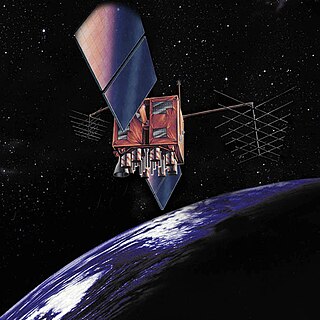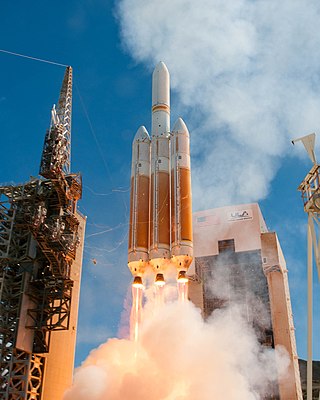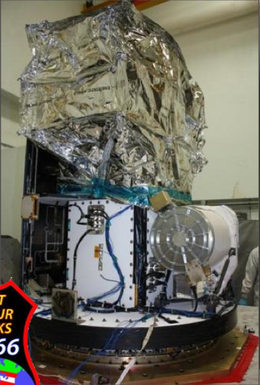
The Minotaur is a family of United States solid fuel launch vehicles derived from converted Minuteman and Peacekeeper intercontinental ballistic missiles (ICBM). They are built by Northrop Grumman via contract with the Air Force Space and Missile Systems Center's Space Development and Test Directorate (SMC/SD) as part of the Air Force's Rocket Systems Launch Program which converts retired Intercontinental Ballistic Missiles into space and test launch systems for U.S. government agencies.

This article outlines notable events occurring in 2005 in spaceflight, including major launches and EVAs. 2005 saw Iran launch its first satellite.

USA-200, also known as NRO Launch 28 or NROL-28, is an American signals intelligence satellite, operated by the National Reconnaissance Office. Launched in 2008, it has been identified as the second satellite in a series known as Improved Trumpet, Advanced Trumpet, or Trumpet follow-on; a replacement for the earlier Trumpet series of satellites.

Minotaur IV, also known as Peacekeeper SLV and OSP-2 PK is an active expendable launch system derived from the LGM-118 Peacekeeper ICBM. It is operated by Northrop Grumman Innovation Systems, and made its maiden flight on 22 April 2010, carrying the HTV-2a Hypersonic Test Vehicle. The first orbital launch occurred on 26 September 2010 with the SBSS satellite for the United States Air Force.

USA 202, previously NRO Launch 26 or NROL-26, is a classified spacecraft which is operated by the United States National Reconnaissance Office. It is an Advanced Orion ELINT satellite. According to Aviation Week, it "fundamentally involves America's biggest, most secret and expensive military spacecraft on board the world's largest rocket." The combined cost of the spacecraft and launch vehicle has been estimated to be over US$2 billion.
Kosmos 225, also known as DS-U1-Ya No.2, was a Soviet satellite which was launched in 1968 as part of the Dnepropetrovsk Sputnik programme. It was a 400 kilograms (880 lb) spacecraft, which was built by the Yuzhnoye Design Bureau, and was used to investigate cosmic rays and flows of charged particles in the Earth's magnetosphere.
Kosmos 321, also known as DS-U2-MG No.1, was a Soviet satellite which was launched in 1970 as part of the Dnepropetrovsk Sputnik programme. It was a 365-kilogram (805 lb) spacecraft, which was built by the Yuzhnoye Design Bureau, and was used to investigate the magnetic poles of the Earth.
USA-227, known before launch as NRO Launch 27 (NROL-27), is an American communications satellite which was launched in 2011. It is operated by the United States National Reconnaissance Office.
USA-229, known before launch as NRO Launch 34 (NROL-34), is a pair of American signals intelligence satellites which were launched in 2011. They are operated by the United States National Reconnaissance Office.
USA-221, also known as FalconSat-5, is an American military minisatellite, which was launched in 2010. The fifth FalconSat spacecraft to be launched, it carries four technology development and ionospheric research experiments. The satellite was constructed and is operated by the United States Air Force Academy.
USA-215, also known as NRO Launch 41 or NROL-41, is an American reconnaissance satellite, operated by the National Reconnaissance Office (NRO). Launched in 2010, it has been identified as the first in a new series of imaging radar satellites, developed as part of the Future Imagery Architecture (FIA) programme, to replace the earlier Lacrosse spacecraft.
USA-234, also known as NRO Launch 25 or NROL-25, is an American reconnaissance satellite, operated by the National Reconnaissance Office. Launched from Vandenberg Air Force Base in 2012, it has been identified as the second radar imaging satellite to be launched as part of the Future Imagery Architecture programme.
USA-184, also known as NRO Launch 22 or NROL-22, is an American signals intelligence satellite, operated by the National Reconnaissance Office. Launched in 2006, it has been identified as the first in a new series of satellites which are replacing the earlier Trumpet spacecraft.

USA-166, also known as GPS IIR-8 and GPS SVN-56, is an American navigation satellite which forms part of the Global Positioning System. It was the eighth Block IIR GPS satellite to be launched, out of thirteen in the original configuration, and twenty one overall. It was built by Lockheed Martin, using the AS-4000 satellite bus.

USA-199, also known as GPS IIR-18(M), GPS IIRM-5 and GPS SVN-57, is an American navigation satellite which forms part of the Global Positioning System. It was the fifth of eight Block IIRM satellites to be launched, and the eighteenth of twenty one Block IIR satellites overall. It was built by Lockheed Martin, using the AS-4000 satellite bus.

USA-245 or NRO Launch 65 (NROL-65) is an American reconnaissance satellite which is operated by the National Reconnaissance Office. Launched in August 2013, it is the last Block 4 KH-11 reconnaissance satellite, and the last official spacecraft to be launched in the Keyhole program.

USA-247, also known as NRO Launch 39 or NROL-39, is an American reconnaissance satellite, operated by the National Reconnaissance Office and launched in December 2013. The USA-247 launch received a relatively high level of press coverage due to the mission's choice of logo, which depicts an octopus sitting astride the globe with the motto "Nothing Is Beyond Our Reach". The logo was extensively criticized in light of the surveillance disclosures in July 2013.

USA-239, also known as GPS IIF-3, GPS SVN-65, and Navstar-67 is an American navigation satellite which forms part of the Global Positioning System. It was the third of twelve Block IIF satellites to be launched.










